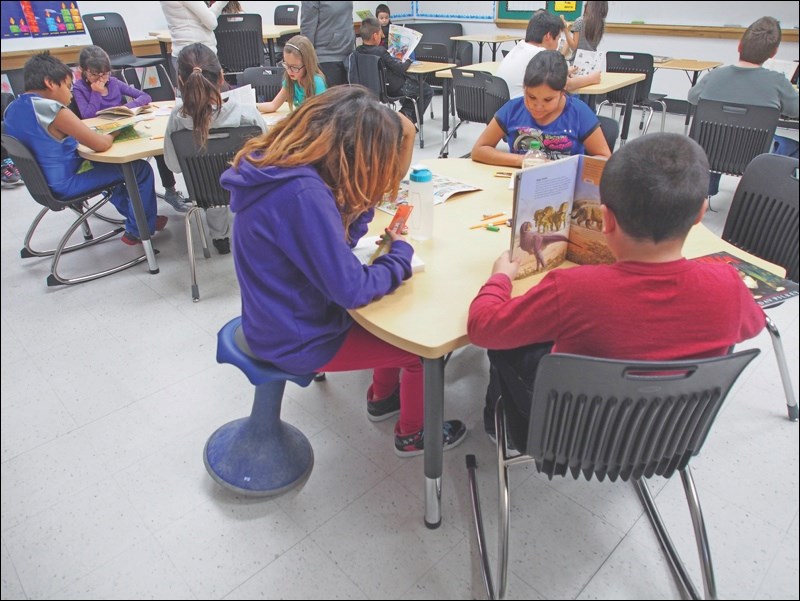“We are built to move,” says occupational therapist Melanie Read. “Movement can be good for everybody…it helps with learning, getting you more attentive, waking up your body and brain, giving you more energy.”
Across the country, office environments are evolving to better support movement and reduce sitting time for workers, with ball chairs, standing desks and collaborative workspaces replacing standard equipment.
Here in Flin Flon, education officials are looking at ways to increase student engagement by changing out the furniture.
Last fall, the Flin Flon School Division took out the traditional seating arrangements in two classrooms, a Grade 2 class at École McIsaac School and a Grade 4 class at Ruth Betts Community School.
The old desks and chairs were replaced with a range of seating options that include soft plastic stools that allow students to bounce and turn in their seats, high chairs and tables, pod-like tables that support collaborative work, a loveseat, and standard chairs that have been modified to rock forwards and backwards.
The classroom transformations, part of an initiative called Active Learning Classrooms, cost the division about $10,000, says superintendent Blaine Veitch.
“There is a growing body of educational research showing that many students can benefit from classrooms that are designed to allow students different seating/standing/movement opportunities as they learn,” says Veitch. “Our goal is to see if there is support for this research within our own classrooms.”
Read was brought on as an advisor for the project. She has found that an active seating approach to classroom design, as opposed to special seating modifications for certain students, enables all students to discover how they learn best and make choices that help them to be successful.
“What I like about this classroom is the ability to change position,” Read says. “A kid is not just stuck with the chair they have, they can rotate and trade around, they can choose different places in the class to sit.”
And not every seating option works for every student, as Grade 4 teacher Patti Lawrence has observed. Her classroom is one of the pilot classes and while students have assigned seats each day, they can choose the type of chair they use and can also ask to sit in one of the special areas during a class.
“The first week we rotated through so everyone could try everything,” she explains.
Over time, students gravitated to what worked for them, Lawrence says.
“For kids with special needs, a lot of them are seeking out movement and [active seating] lets them move, but in an acceptable way that’s not super distracting,” says Read.
Lawrence says she has seen a difference already. “I’ve seen [students] rocking a lot when I’m teaching or when they are working…before they might get up and wander, now they are rocking instead of wandering.”
In contrast, some students prefer not to move at all, or choose to sit in a traditional, static chair when working on tasks that require more concentration and balance, like handwriting.
Lawrence says she has also observed “more sharing and helping out” among students sitting at the pod-type desk set-ups. These replaced groupings of two or three student desks positioned side by side.
If the pilot classrooms are found to be successful, more Flin Flon students may be seeing their classroom landscapes change.
“If we are finding there are benefits to children, then we plan to expand to some other classrooms,” says Veitch. “And to provide teacher training that supports this type of learning environment.”




